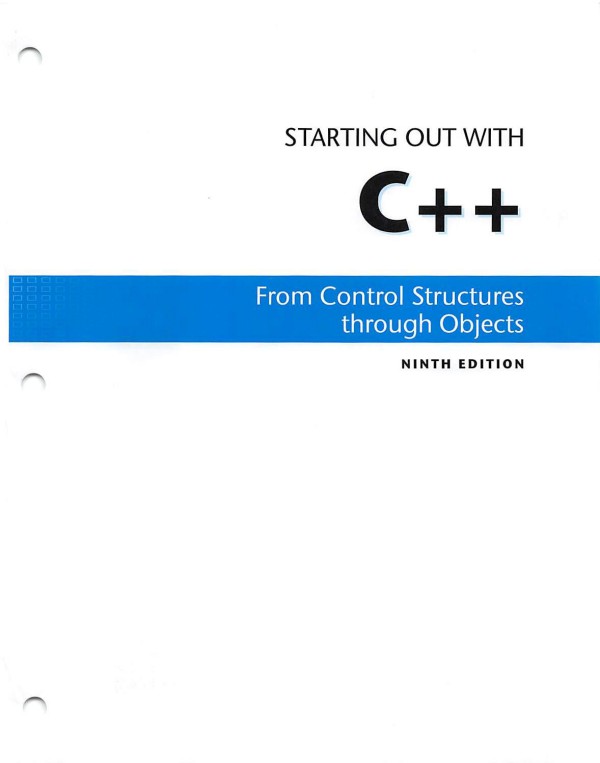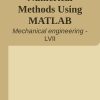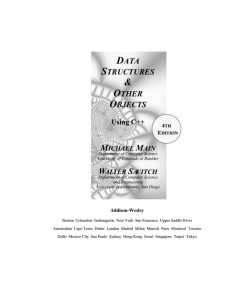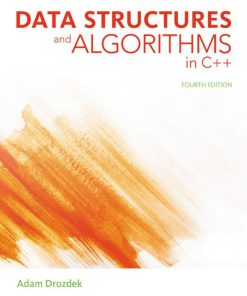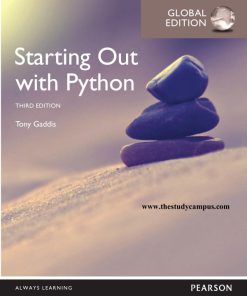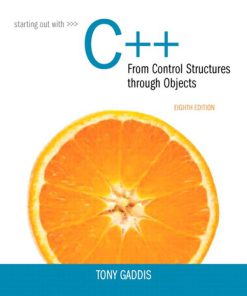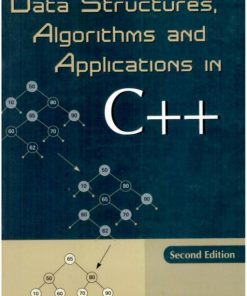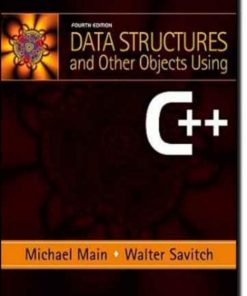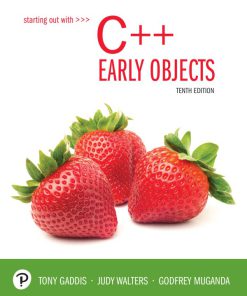Starting Out With C From Control Structures Through Objects With Myprogramminglab Access Code 9th Edition by Tony Gaddis 0134498372 9780134498379
$50.00 Original price was: $50.00.$25.00Current price is: $25.00.
Authors:Tony Gaddis , Series:Computer Science [85] , Tags:Computers; Programming Languages; C , Author sort:Gaddis, Tony , Ids:Google; 9780133796339 , Languages:Languages:eng , Published:Published:Mar 2014 , Publisher:Pearson Education , Comments:Comments:NOTE: Before purchasing, check with your instructor to ensure you select the correct ISBN. Several versions of Pearson’s MyLab & Mastering products exist for each title, and registrations are not transferable. To register for and use Pearson’s MyLab & Mastering products, you may also need a Course ID, which your instructor will provide. Used books, rentals, and purchases made outside of Pearson If purchasing or renting from companies other than Pearson, the access codes for Pearson’s MyLab & Mastering products may not be included, may be incorrect, or may be previously redeemed. Check with the seller before completing your purchase. This text is intended for either a one-semester accelerated introductory course or a traditional two-semester sequence covering C++ programming. It is also suitable for readers interested in a comprehensive introduction to C++ programming.  Tony Gaddis”s accessible, step-by-step presentation helps beginning students understand the important details necessary to become skilled programmers at an introductory level. Gaddis motivates the study of both programming skills and the C++ programming language by presenting all the details needed to understand the “how” and the “why”–but never losing sight of the fact that most beginners struggle with this material. His approach is both gradual and highly accessible, ensuring that students understand the logic behind developing high-quality programs.  In Starting Out with C++: From Control Structures through Objects, Gaddis covers control structures, functions, arrays, and pointers before objects and classes. As with all Gaddis texts, clear and easy-to-read code listings, concise and practical real-world examples, and an abundance of exercises appear in every chapter.  MyProgrammingLab for Starting Out with C++ is a total learning package. MyProgrammingLab is an online homework, tutorial, and assessment program that truly engages students in learning. It helps students better prepare for class, quizzes, and exams-resulting in better performance in the course-and provides educators a dynamic set of tools for gauging individual and class progress.  Teaching and Learning Experience This program presents a better teaching and learning experience–for you and your students. It will help: Personalize Learning with MyProgrammingLab: Through the power of practice and immediate personalized feedback, MyProgrammingLab helps students fully grasp the logic, semantics, and syntax of programming. Enhance Learning with the Gaddis Approach: Gaddis”s accessible approach features clear and easy-to-read code listings, concise real-world examples, and exercises in every chapter. Keep Your Course Current: This edition introduces many of the new C++11 language features. Support Instructors and Students: Student and instructor resources are available to expand on the topics presented in the text. Note: Starting Out with C++ from Control Structures to Objects with MyProgrammingLab Access Card Package, 8/e contains: ISBN-10: 0133769399/ISBN-13: 9780133769395 Starting Out with C++ from Control Structures to Objects , 8/e ISBN-10: 0133780619/ISBN-13: 9780133780611 MyProgrammingLab with Pearson eText — Access Card — for Starting Out with C++ from Control Structures to Objects, 8/e MyProgrammingLab is not a self-paced technology and should only be purchased when required by an instructor.
Starting Out With C From Control Structures Through Objects With Myprogramminglab Access Code 9th Edition by Tony Gaddis – Ebook PDF Instant Download/Delivery. 0134498372, 9780134498379
Full download Starting Out With C From Control Structures Through Objects With Myprogramminglab Access Code 9th Edition after payment
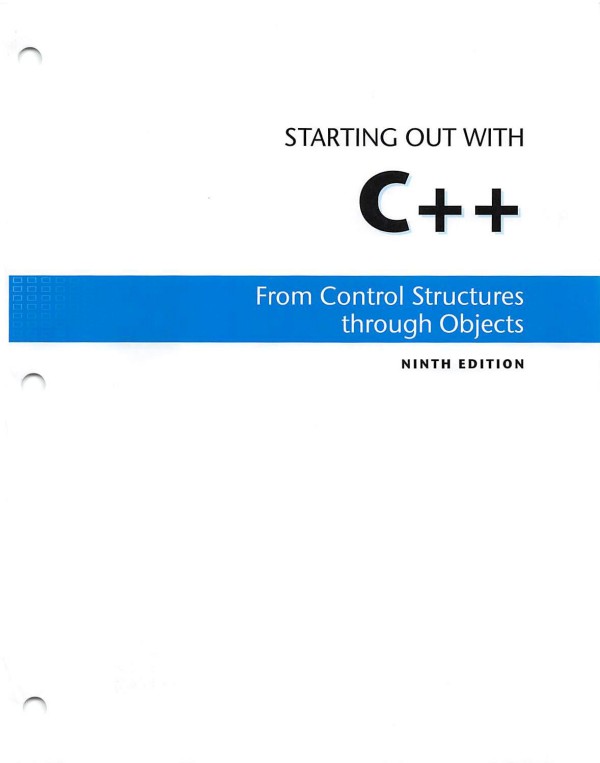
Product details:
ISBN 10: 0134498372
ISBN 13: 9780134498379
Author: Tony Gaddis
For two-semester courses in the C++ programming sequence, or an accelerated one-semester course. A clear and student-friendly way to teach the fundamentals of C++ Starting Out with C++: From Control Structures through Objects covers control structures, functions, arrays, and pointers before objects and classes in Tony Gaddis’s hallmark accessible, step-by-step presentation. His books help beginning students understand the important details necessary to become skilled programmers at an introductory level. Gaddis motivates the study of both programming skills and the C++ programming language by presenting all the details needed to understand the “how” and the “why”–but never losing sight of the fact that most beginners struggle with this material. His approach is gradual and highly accessible, ensuring that students understand the logic behind developing high-quality programs. As with all Gaddis texts, clear and easy-to-read code listings, concise and practical real-world examples, and an abundance of exercises appear in every chapter. Updates to the 9th Edition include revised, improved problems throughout and a new chapter featuring completely rewritten and expanded material on the Standard Template Library (STL). Also Available with MyLab Programming. MyLab™ Programming is an online learning system designed to engage students and improve results. MyLab Programming consists of programming exercises correlated to the concepts and objectives in this book. Through practice exercises and immediate, personalized feedback, MyLab Programming improves the programming competence of beginning students who often struggle with the basic concepts of programming languages. Note: You are purchasing a standalone product; MyLab™ & Mastering™ does not come packaged with this content. Students, if interested in purchasing this title with MyLab & Mastering, ask your instructor for the correct package ISBN and Course ID. Instructors, contact your Pearson representative for more information. If you would like to purchase both the physical text and MyLab & Mastering, search for: 0134544846 / 9780134544847 Starting Out with C++ from Control Structures to Objects Plus MyProgrammingLab with Pearson eText — Access Card Package, 9/e Package consists of:
Starting Out With C From Control Structures Through Objects With Myprogramminglab Access Code 9th Table of contents:
Chapter 1 Introduction to Computers and Programming
Topics
1.1 Why Program?
1.2 Computer Systems: Hardware and Software
Hardware
The CPU
Main Memory
Secondary Storage
Input Devices
Output Devices
Software
System Software
Application Software
Checkpoint
1.3 Programs and Programming Languages
What Is a Program?
Programming Languages
Source Code, Object Code, and Executable Code
Checkpoint
1.4 What Is a Program Made of?
Language Elements
Key Words (Reserved Words)
Programmer-Defined Identifiers
Operators
Punctuation
Lines and Statements
Variables
Variable Definitions
1.5 Input, Processing, and Output
Checkpoint
1.6 The Programming Process
Designing and Creating a Program
What Is Software Engineering?
1.7 Procedural and Object-Oriented Programming
Checkpoint
Review Questions and Exercises
Short Answer
Fill-in-the-Blank
Algorithm Workbench
Predict the Result
Find the Error
Chapter 2 Introduction to C++
Topics
2.1 The Parts of a C++ Program
Checkpoint
2.2 The cout Object
2.3 The #include Directive
Checkpoint
2.4 Variables, Literals, and Assignment Statements
Sometimes a Number Isn’t a Number
Literals
Checkpoint
2.5 Identifiers
Legal Identifiers
2.6 Integer Data Types
Integer and Long Integer Literals
If You Plan to Continue in Computer Science: Hexadecimal and Octal Literals
Checkpoint
2.7 The char Data Type
The Difference between String Literals and Character Literals
2.8 The C++ string Class
Using the string Class
Checkpoint
2.9 Floating-Point Data Types
Floating-Point Literals
Assigning Floating-Point Values to Integer Variables
2.10 The bool Data Type
2.11 Determining the Size of a Data Type
Checkpoint
2.12 More about Variable Assignments and Initialization
Declaring Variables with the auto Key Word
Alternative Forms of Variable Initialization
2.13 Scope
2.14 Arithmetic Operators
Integer Division
Checkpoint
2.15 Comments
Single-Line Comments
Multi-Line Comments
2.16 Named Constants
Checkpoint
2.17 Programming Style
Review Questions and Exercises
Short Answer
Multiple Choice
True or False
Algorithm Workbench
Find the Error
Programming Challenges
Chapter 3 Expressions and Interactivity
Topics
3.1 The cin Object
Entering Multiple Values
Checkpoint
3.2 Mathematical Expressions
Operator Precedence
Associativity
Grouping with Parentheses
Converting Algebraic Expressions to Programming Statements
No Exponents Please!
Checkpoint
3.3 When You Mix Apples and Oranges: Type Conversion
Integer Division
3.4 Overflow and Underflow
3.5 Type Casting
Checkpoint
3.6 Multiple Assignment and Combined Assignment
Combined Assignment Operators
Checkpoint
3.7 Formatting Output
The setprecision Manipulator
The fixed Manipulator
The showpoint Manipulator
The left and right Manipulators
Checkpoint
3.8 Working with Characters and string Objects
Inputting a Character
Using cin.get
Mixing cin >> and cin.get
Using cin.ignore
string Member Functions and Operators
3.9 More Mathematical Library Functions
Random Numbers
Checkpoint
3.10 Focus on Debugging: Hand Tracing a Program
3.11 Focus on Problem Solving: A Case Study
Variables
Program Design
Calculations
The Program
Review Questions and Exercises
Short Answer
Fill-in-the-Blank
Algorithm Workbench
Find the Errors
Predict the Output
Programming Challenges
Chapter 4 Making Decisions
Topics
4.1 Relational Operators
The Value of a Relationship
What Is Truth?
Checkpoint
4.2 The if Statement
Be Careful with Semicolons
Programming Style and the if Statement
Comparing Floating-Point Numbers
And Now Back to Truth
Don’t Confuse == with =
Checkpoint
4.3 Expanding the if Statement
Don’t Forget the Braces!
Checkpoint
4.4 The if/else Statement
Checkpoint
4.5 Nested if Statements
Programming Style and Nested Decision Structures
Testing a Series of Conditions
Checkpoint
4.6 The if/else if Statement
Using the Trailing else to Catch Errors
The if/else if Statement Compared to a Nested Decision Structure
Checkpoint
4.7 Flags
Integer Flags
4.8 Logical Operators
The && Operator
The || Operator
The ! Operator
Precedence and Associativity of Logical Operators
4.9 Checking Numeric Ranges with Logical Operators
Checkpoint
4.10 Menus
4.11 Focus on Software Engineering: Validating User Input
4.12 Comparing Characters and Strings
Comparing Characters
Comparing string Objects
Checkpoint
4.13 The Conditional Operator
Using the Value of a Conditional Expression
Checkpoint
4.14 The switch Statement
Using switch in Menu Systems
Checkpoint
4.15 More about Blocks and Variable Scope
Variables with the Same Name
Review Questions and Exercises
Short Answer
Fill-in-the-Blank
Algorithm Workbench
True or False
Find the Errors
Programming Challenges
Chapter 5 Loops and Files
Topics
5.1 The Increment and Decrement Operators
The Difference between Postfix and Prefix Modes
Using ++ and −− in Mathematical Expressions
Using ++ and −− in Relational Expressions
Checkpoint
5.2 Introduction to Loops: The while Loop
The while Loop
The while Loop Is a Pretest Loop
Infinite Loops
Don’t Forget the Braces with a Block of Statements
Programming Style and the while Loop
5.3 Using the while Loop for Input Validation
Checkpoint
5.4 Counters
5.5 The do-while Loop
Using do-while with Menus
Checkpoint
5.6 The for Loop
Using the for Loop instead of while or do-while
The for Loop Is a Pretest Loop
Avoid Modifying the Counter Variable in the Body of the for Loop
Other Forms of the Update Expression
Defining a Variable in the for Loop’s Initialization Expression
Creating a User-Controlled for Loop
Using Multiple Statements in the Initialization and Update Expressions
Omitting the for Loop’s Expressions
Checkpoint
5.7 Keeping a Running Total
5.8 Sentinels
Checkpoint
5.9 Focus on Software Engineering: Deciding Which Loop to Use
5.10 Nested Loops
5.11 Using Files for Data Storage
Types of Files
File Access Methods
Filenames and File Stream Objects
Setting Up a Program for File Input/Output
Creating a File Object and Opening a File
Closing a File
Writing Data to a File
Reading Data from a File
The Read Position
Reading Numeric Data from a Text File
Using Loops to Process Files
Detecting the End of the File
Testing for File Open Errors
Letting the User Specify a Filename
Using the c_str Member Function in Older Versions of C++
Checkpoint
5.12 Optional Topics: Breaking and Continuing a Loop
Using break in a Nested Loop
The continue Statement
Review Questions and Exercises
Short Answer
Fill-in-the-Blank
Algorithm Workbench
True or False
Find the Errors
Programming Challenges
Chapter 6 Functions
Topics
6.1 Focus on Software Engineering: Modular Programming
6.2 Defining and Calling Functions
void Functions
Calling a Function
Checkpoint
6.3 Function Prototypes
6.4 Sending Data into a Function
6.5 Passing Data by Value
6.6 Focus on Software Engineering: Using Functions in a Menu-Driven Program
Checkpoint
6.7 The return Statement
6.8 Returning a Value from a Function
Defining a Value-Returning Function
Calling a Value-Returning Function
6.9 Returning a Boolean Value
Checkpoint
6.10 Local and Global Variables
Local Variables
Local Variable Lifetime
Initializing Local Variables with Parameter Values
Global Variables
Global Constants
Local and Global Variables with the Same Name
6.11 Static Local Variables
Checkpoint
6.12 Default Arguments
6.13 Using Reference Variables as Parameters
Checkpoint
6.14 Overloading Functions
6.15 The exit() Function
Checkpoint
6.16 Stubs and Drivers
Review Questions and Exercises
Short Answer
Fill-in-the-Blank
Algorithm Workbench
True or False
Find the Errors
Programming Challenges
Group Project
Chapter 7 Arrays and Vectors
Topics
7.1 Arrays Hold Multiple Values
Memory Requirements of Arrays
7.2 Accessing Array Elements
Inputting and Outputting Array Contents
Array Initialization
Partial Array Initialization
Implicit Array Sizing
Reading Data from a File into an Array
Writing the Contents of an Array to a File
7.3 No Bounds Checking in C++
Watch for Off-by-One Errors
Checkpoint
7.4 The Range-Based for Loop
Modifying an Array with a Range-Based for Loop
The Range-Based for Loop versus the Regular for Loop
7.5 Processing Array Contents
Thou Shall Not Assign
Printing the Contents of an Array
Summing the Values in a Numeric Array
Getting the Average of the Values in a Numeric Array
Finding the Highest and Lowest Values in a Numeric Array
Partially Filled Arrays
Comparing Arrays
7.6 Focus on Software Engineering: Using Parallel Arrays
Checkpoint
7.7 Arrays as Function Arguments
Using const Array Parameters
Some Useful Array Functions
Checkpoint
7.8 Two-Dimensional Arrays
Passing Two-Dimensional Arrays to Functions
Summing All the Elements of a Two-Dimensional Array
Summing the Rows of a Two-Dimensional Array
Summing the Columns of a Two-Dimensional Array
7.9 Arrays with Three or More Dimensions
Checkpoint
7.10 Focus on Problem Solving and Program Design: A Case Study
7.11 Introduction to the STL vector
Defining a vector
Using an Initialization List with a vector in C++ 11
Storing and Retrieving Values in a vector
Using the Range-Based for Loop with a vector in C++ 11
Using the push_back Member Function
Determining the Size of a vector
Removing Elements from a vector
Clearing a vector
Detecting an Empty vector
Summary of vector Member Functions
Checkpoint
Review Questions and Exercises
Short Answer
Fill-in-the-Blank
Algorithm Workbench
True or False
Find the Errors
Programming Challenges
Group Project
Chapter 8 Searching and Sorting Arrays
Topics
8.1 Focus on Software Engineering: Introduction to Search Algorithms
The Linear Search
Inefficiency of the Linear Search
The Binary Search
The Efficiency of the Binary Search
8.2 Focus on Problem Solving and Program Design: A Case Study
Variables
Modules
Function main
The getProdNum Function
The binarySearch Function
The displayProd Function
The Entire Program
Checkpoint
8.3 Focus on Software Engineering: Introduction to Sorting Algorithms
Sorting Algorithms
The Bubble Sort
Swapping Array Elements
The Selection Sort Algorithm
8.4 Focus on Problem Solving and Program Design: A Case Study
Variables
Modules
Function main
The calcSales Function
The dualSort Function
The Overloaded swap Functions
The showOrder Function
The showTotals Function
The Entire Program
8.5 Sorting and Searching vectors (Continued from Section 7.11)
Review Questions and Exercises
Short Answer
Fill-in-the-Blank
True or False
Programming Challenges
Chapter 9 Pointers
Topics
9.1 Getting the Address of a Variable
9.2 Pointer Variables
Creating and Using Pointer Variables
9.3 The Relationship between Arrays and Pointers
9.4 Pointer Arithmetic
9.5 Initializing Pointers
Checkpoint
9.6 Comparing Pointers
9.7 Pointers as Function Parameters
Pointers to Constants
Passing a Nonconstant Argument into a Pointer to a Constant
Constant Pointers
Constant Pointers to Constants
9.8 Dynamic Memory Allocation
9.9 Returning Pointers from Functions
Checkpoint
9.10 Using Smart Pointers to Avoid Memory Leaks
9.11 Focus on Problem Solving and Program Design: A Case Study
Variables
Programming Strategy
Functions
Function main
The arrSelectSort Function
The showArrPtr Function
The showArray Function
The Entire Program
Review Questions and Exercises
Short Answer
Fill-in-the-Blank
Algorithm Workbench
True or False
Find the Error
Programming Challenges
Chapter 10 Characters, C-Strings, and More about the string Class
Topics
10.1 Character Testing
10.2 Character Case Conversion
Checkpoint
10.3 C-Strings
More about String Literals
C-Strings Stored in Arrays
10.4 Library Functions for Working with C-Strings
The strlen Function
The strcat Function
The strcpy Function
The strncat and strncpy Functions
The strstr Function
The strcmp Function
Using ! with strcmp
Sorting Strings
Checkpoint
10.5 String/Numeric Conversion Functions
The string to Number Functions
The to_string Function
Checkpoint
10.6 Focus on Software Engineering: Writing Your Own C-String-Handling Functions
Using Pointers to Pass C-String Arguments
Checkpoint
10.7 More about the C++ string Class
Using the string Class
Reading a Line of Input into a string Object
Comparing and Sorting string Objects
Other Ways to Define string Objects
Using string Class Member Functions
10.8 Focus on Problem Solving and Program Design: A Case Study
Review Questions and Exercises
Short Answer
Fill-in-the-Blank
Algorithm Workbench
True or False
Find the Errors
Programming Challenges
Chapter 11 Structured Data
Topics
11.1 Abstract Data Types
Abstraction
Data Types
Abstract Data Types
11.2 Structures
11.3 Accessing Structure Members
Comparing Structure Variables
11.4 Initializing a Structure
Checkpoint
11.5 Arrays of Structures
Initializing a Structure Array
11.6 Focus on Software Engineering: Nested Structures
Checkpoint
11.7 Structures as Function Arguments
Constant Reference Parameters
11.8 Returning a Structure from a Function
11.9 Pointers to Structures
Dynamically Allocating a Structure
11.10 Focus on Software Engineering: When to Use ., When to Use −>, and When to Use *
Checkpoint
11.11 Enumerated Data Types
Assigning an Integer to an enum Variable
Assigning an Enumerator to an int Variable
Comparing Enumerator Values
Anonymous Enumerated Types
Using Math Operators to Change the Value of an enum Variable
Using an enum Variable to Step through an Array’s Elements
Using Enumerators to Output Values
Specifying Integer Values for Enumerators
Enumerators Must Be Unique within the Same Scope
Declaring the Type and Defining the Variables in One Statement
Using Strongly Typed enums in C++ 11
Checkpoint
Review Questions and Exercises
Short Answer
Fill-in-the-Blank
Algorithm Workbench
True or False
Find the Errors
Programming Challenges
Chapter 12 Advanced File Operations
Topics
12.1 File Operations
Using the fstream Data Type
File Open Modes with ifstream and ofstream Objects
Checking for a File’s Existence Before Opening It
Opening a File with the File Stream Object Definition Statement
Checkpoint
12.2 File Output Formatting
12.3 Passing File Stream Objects to Functions
12.4 More Detailed Error Testing
12.5 Member Functions for Reading and Writing Files
The getline Function
The get Member Function
The put Member Function
Checkpoint
12.6 Focus on Software Engineering: Working with Multiple Files
12.7 Binary Files
The write and read Member Functions
Writing Data other than char to Binary Files
12.8 Creating Records with Structures
12.9 Random-Access Files
The seekp and seekg Member Functions
The tellp and tellg Member Functions
Rewinding a Sequential-Access File with seekg
12.10 Opening a File for Both Input and Output
Checkpoint
Review Questions and Exercises
Short Answer
Fill-in-the-Blank
Algorithm Workbench
True or False
Find the Error
Programming Challenges
Group Project
Chapter 13 Introduction to Classes
Topics
13.1 Procedural and Object-Oriented Programming
Object Reusability
Classes and Objects
Using a Class You Already Know
13.2 Introduction to Classes
Access Specifiers
Public Member Functions
Using const with Member Functions
Placement of public and private Members
Defining Member Functions
Accessors and Mutators
Using const with Accessors
The Importance of Data Hiding
13.3 Defining an Instance of a Class
Accessing an Object’s Members
A Class Demonstration Program
Avoiding Stale Data
Pointers to Objects
Using Smart Pointers to Allocate Objects
Checkpoint
13.4 Why Have Private Members?
13.5 Focus on Software Engineering: Separating Class Specification from Implementation
13.6 Inline Member Functions
Inline Functions and Performance
Checkpoint
13.7 Constructors
Using Member Initialization Lists
In-Place Member Initialization
The Default Constructor
Default Constructors and Dynamically Allocated Objects
13.8 Passing Arguments to Constructors
Using Default Arguments with Constructors
More about the Default Constructor
Classes with No Default Constructor
13.9 Destructors
Destructors and Dynamically Allocated Class Objects
Checkpoint
13.10 Overloading Constructors
Constructor Delegation
Only One Default Constructor and One Destructor
Other Overloaded Member Functions
13.11 Private Member Functions
13.12 Arrays of Objects
Accessing Members of Objects in an Array
Checkpoint
13.13 Focus on Problem Solving and Program Design: An OOP Case Study
Private Member Variables
Public Member Functions
The Class Declaration
The withdraw Member Function
The Class’s Interface
Implementing the Class
13.14 Focus on Object-Oriented Programming: Simulating Dice with Objects
13.15 Focus on Object-Oriented Design: The Unified Modeling Language (UML)
Showing Access Specification in UML Diagrams
Data Type and Parameter Notation in UML Diagrams
Showing Constructors and Destructors in a UML Diagram
13.16 Focus on Object-Oriented Design: Finding the Classes and Their Responsibilities
Finding the Classes
Write a Description of the Problem Domain
Identify All of the Nouns
Refine the List of Nouns
Identifying a Class’s Responsibilities
The Customer class
The Car Class
The ServiceQuote Class
This Is Only the Beginning
Checkpoint
Review Questions and Exercises
Short Answer
Fill-in-the-Blank
Algorithm Workbench
True or False
Find the Errors
Programming Challenges
Group Project
Chapter 14 More about Classes
Topics
14.1 Instance and Static Members
Instance Variables
Static Members
Static Member Variables
Static Member Functions
14.2 Friends of Classes
Checkpoint
14.3 Memberwise Assignment
14.4 Copy Constructors
Using const Parameters in Copy Constructors
Copy Constructors and Function Parameters
The Default Copy Constructor
Checkpoint
14.5 Operator Overloading
The this Pointer
Overloading the = Operator
Checking for Self-Assignment
The = Operator’s Return Value
Copy Assignment
Some General Issues of Operator Overloading
Overloading Math Operators
Overloading the Prefix ++ Operator
Overloading the Postfix ++ Operator
Checkpoint
Overloading Relational Operators
Overloading the <> Operators
Overloading the [ ] Operator
Checkpoint
14.6 Object Conversion
Checkpoint
14.7 Aggregation
Using Member Initialization Lists with Aggregate Classes
Aggregation in UML Diagrams
14.8 Focus on Object-Oriented Design: Class Collaborations
Determining Class Collaborations with CRC Cards
Checkpoint
14.9 Focus on Object-Oriented Programming: Simulating the Game of Cho-Han
14.10 Rvalue References and Move Semantics
Lvalues and Rvalues
Rvalue References
Move Semantics
When to Implement Move Semantics in a Class
Default Operations Provided by the Compiler
Review Questions and Exercises
Short Answer
Fill-in-the-Blank
Algorithm Workbench
True or False
Find the Errors
Programming Challenges
Chapter 15 Inheritance, Polymorphism, and Virtual Functions
Topics
15.1 What Is Inheritance?
Generalization and Specialization
Inheritance and the “Is a” Relationship
Checkpoint
15.2 Protected Members and Class Access
More about Base Class Access Specification
Checkpoint
15.3 Constructors and Destructors in Base and Derived Classes
Passing Arguments to Base Class Constructors
Constructor Inheritance
Checkpoint
15.4 Redefining Base Class Functions
15.5 Class Hierarchies
15.6 Polymorphism and Virtual Member Functions
Polymorphism Requires References or Pointers
Base Class Pointers
Base Class Pointers and References Know Only about Base Class Members
The “Is-a” Relationship Does Not Work in Reverse
Redefining versus Overriding
Virtual Destructors
C++ 11’s override and final Key Words
Preventing a Member Function from Being Overridden
15.7 Abstract Base Classes and Pure Virtual Functions
Checkpoint
15.8 Multiple Inheritance
Checkpoint
Review Questions and Exercises
Short Answer
Fill-in-the-Blank
Algorithm Workbench
True or False
Find the Errors
Programming Challenges
Group Project
Chapter 16 Exceptions and Templates
Topics
16.1 Exceptions
Throwing an Exception
Handling an Exception
What if an Exception Is Not Caught?
Object-Oriented Exception Handling with Classes
Multiple Exceptions
Using Exception Handlers to Recover from Errors
Extracting Data from the Exception Class
Unwinding the Stack
Rethrowing an Exception
Handling the bad_alloc Exception
Checkpoint
16.2 Function Templates
Introduction
Using Operators in Function Templates
Function Templates with Multiple Types
Overloading with Function Templates
16.3 Focus on Software Engineering: Where to Start When Defining Templates
Checkpoint
16.4 Class Templates
Defining Objects of the Class Template
Class Templates and Inheritance
Specialized Templates
Checkpoint
Review Questions and Exercises
Short Answer
Fill-in-the-Blank
Algorithm Workbench
True or False
Find the Error
Programming Challenges
Chapter 17 The Standard Template Library
Topics
17.1 Introduction to the Standard Template Library
17.2 STL Container and Iterator Fundamentals
Containers
Introduction to the array Class
Iterators
Defining an Iterator
Getting an Iterator from a Container Object
Using auto to Define an Iterator
Mutable Iterators and const_iterators
Reverse Iterators
Checkpoint
17.3 The vector Class
Review of Basic vector Operations
Using an Iterator with a vector
Inserting New Elements into a vector
Storing Objects of Your Own Classes as Values in a vector
Inserting Elements with the emplace()and emplace_back()Member Functions
The capacity(), max_size(), shrink_to_fit(), and reserve() Member Functions
Checkpoint
17.4 The map, multimap, and unordered_map Classes
The map Class
Initializing a Map
Adding Elements to an Existing Map
Adding Elements with the insert() Member Function
Adding Elements with the emplace() Member Function
Retrieving Values from a Map
Deleting Elements
Iterating Over a Map with the Range-Based for Loop
Using an Iterator with a Map
Storing vectors as Values in a map
Storing Objects of Your Own Classes as Values in a map
Using an Object of Your Own Class as a Key
The unordered_map Class
The multimap Class
Adding Elements to a multimap
Getting the Number of Elements with a Specified Key
Retrieving the Elements with a Specified Key
Deleting Elements from a multimap
The unordered_multimap Class
Checkpoint
17.5 The set, multiset, and unordered_set Classes
Adding Elements to an Existing set
Iterating Over a set with the Range-Based for Loop
Using an Iterator with a set
Determining Whether a Value Exists in a set
Storing Objects of Your Own Classes in a set
The multiset Class
The unordered_set and unordered_multiset Classes
Checkpoint
17.6 Algorithms
Sorting and Searching Algorithms
Detecting Permutations
Plugging Your Own Functions into an Algorithm
Using the STL to Perform Set Operations
Finding the Union of Sets with the set_union Function
Finding the Intersection of Sets with the set_intersection Function
Finding the Difference of Sets with the set_difference Function
Finding the Symmetric Difference of Sets with the set_symmetric_difference Function
Finding Subsets
17.7 Introduction to Function Objects and Lambda Expressions
Constructing an Anonymous Function Object
Predicate Terminology
Lambda Expressions
Functional Classes in the STL
Checkpoint
Review Questions and Exercises
Short Answer
Fill-in-the-Blank
True or False
Algorithm Workbench
Find the Errors
Programming Challenges
Chapter 18 Linked Lists
Topics
18.1 Introduction to the Linked List ADT
Advantages of Linked Lists over Arrays and vectors
The Composition of a Linked List
Declarations
Checkpoint
18.2 Linked List Operations
Appending a Node to the List
Traversing a Linked List
Inserting a Node
Checkpoint
Deleting a Node
Destroying the List
Checkpoint
18.3 A Linked List Template
Using a Class Node Type
18.4 Variations of the Linked List
18.5 The STL list and forward_list Containers
The list Container
The forward_list Container
Review Questions and Exercises
Short Answer
Fill-in-the-Blank
Algorithm Workbench
True or False
Find the Errors
Programming Challenges
Chapter 19 Stacks and Queues
Topics
19.1 Introduction to the Stack ADT
Definition
Applications of Stacks
Static and Dynamic Stacks
Stack Operations
A Static Stack Class
Implementing Other Stack Operations
A Static Stack Template
19.2 Dynamic Stacks
A Dynamic Stack Template
19.3 The STL stack Container
Checkpoint
19.4 Introduction to the Queue ADT
Definition
Application of Queues
Static and Dynamic Queues
Queue Operations
Detecting Full and Empty Queues with Circular Arrays
A Static Queue Class
A Static Queue Template
19.5 Dynamic Queues
A Dynamic Queue Template
19.6 The STL deque and queue Containers
The deque Container
The queue Container Adapter
Review Questions and Exercises
Short Answer
Fill-in-the-Blank
Algorithm Workbench
True or False
Programming Challenges
Chapter 20 Recursion
Topics
20.1 Introduction to Recursion
20.2 Solving Problems with Recursion
Example: Using Recursion to Calculate the Factorial of a Number
Example: Using Recursion to Count Characters
Direct and Indirect Recursion
Checkpoint
20.3 Focus on Problem Solving and Program Design: The Recursive gcd Function
20.4 Focus on Problem Solving and Program Design: Solving Recursively Defined Problems
20.5 Focus on Problem Solving and Program Design: Recursive Linked List Operations
Counting the Nodes in the List
Displaying List Nodes in Reverse Order
20.6 Focus on Problem Solving and Program Design: A Recursive Binary Search Function
20.7 The Towers of Hanoi
20.8 Focus on Problem Solving and Program Design: The QuickSort Algorithm
20.9 Exhaustive Algorithms
20.10 Focus on Software Engineering: Recursion versus Iteration
Review Questions and Exercises
Short Answer
Fill-in-the-Blank
Algorithm Workbench
Predict the Output
Programming Challenges
Chapter 21 Binary Trees
Topics
21.1 Definition and Applications of Binary Trees
Applications of Binary Trees
Checkpoint
21.2 Binary Search Tree Operations
Creating a Binary Trees
Inserting a Node
Traversing the Tree
Searching the Tree
Deleting a Node
Checkpoint
21.3 Template Considerations for Binary Search Trees
Review Questions and Exercises
Short Answer
Fill-in-the-Blank
Algorithm Workbench
True or False
Programming Challenges
Appendix A The ASCII Character Set
Appendix B Operator Precedence and Associativity
C++ Quick Reference
People also search for Starting Out With C From Control Structures Through Objects With Myprogramminglab Access Code 9th:
starting out with c ++ from control structures through objects
starting out with c++ from control structures through objects
starting out with c from control structures to objects
how to find c in ax2+bx+c

